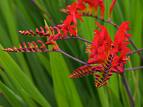 For a real color punch in a hot border Crocosmia will fill the bill. The unusual flowers rise up on tall arching stems and are striking against the tall attractive gladiola-like foliage. The clumps grow from corms and slowly spread. The flowers attract humming birds and butterflies and are good in bouquets; I used them in the bridal bouquet with rust colored calla lilies and alstroemerias for a fall wedding.
For a real color punch in a hot border Crocosmia will fill the bill. The unusual flowers rise up on tall arching stems and are striking against the tall attractive gladiola-like foliage. The clumps grow from corms and slowly spread. The flowers attract humming birds and butterflies and are good in bouquets; I used them in the bridal bouquet with rust colored calla lilies and alstroemerias for a fall wedding.
Type: Herbaceous perennial.
Bloom: Scarlet and yellow flowers hang from stiffly arching tall stems in summer.
Size: 3-4’ H x 1’ W.
Light: Full sun to partial shade, but prefers full sun.
Soil: Average, well drained soil.
Hardiness: Zones 5-9.
Care: In areas with winter temperatures below 0 F, lift corms in the fall.
Pests and Diseases: Spider mite can cause problems.
Propagation: Division or by corm offset.
Companion plants: Scarlet Asiatic lily such as ‘Gran Paridiso’; Sneezeweed (Helenium) ‘Moerheim Beauty’; canna with dark burgundy foliage such as ‘Wyoming’ (has orange flower); butterfly weed (Asclepias tuberosa); dahlia ‘Bishop o Llandaff’.
Comments: Excellent cut flower; attracts butterflies and hummingbirds. Tolerates heat and humidity.

Hi Karen,
I never appreciated my red crocosmia until this year perhaps because they are int the back corner of my garden, but now that I’ve cleared out the area, I’m enjoying the unusual flower and its bright colors. I have had a problem with some dead patches in the middle of the leaves, maybe the spider mite issue.
Feeding my plant additction, I picked up a bright orange-yellow crocosmia yesterday (1/2 off!) called Walburton Yellow ‘Walcroy’. It still has a bloom on it – very pretty!
Jackie
Jackie,
I’m jealous. I want a yellow one!
Karen
I planted them twice, still havent seen a bloom, very disapointed. they are beautiful. maybe next year. Nancy
Nancy,
Crocosmia are pretty tough but like many plants with fleshy underground parts they are susceptible to rot if the soil is wet. Try another site in a drier place. Good luck.
Karen